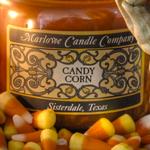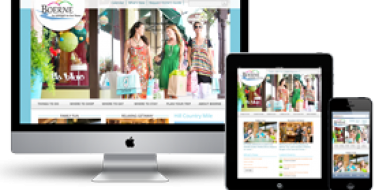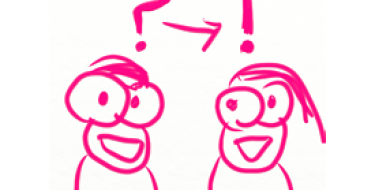Taking the Perfect Product Shot
We're lucky to have a cooler-than-cool, ice-cold client like Marlowe Candle Company. Marlowe specializes in hand-poured, perfectly scented candles of great variety. Their scents range from Honeysuckle to Whiskey Sour and include holiday favorites like Fall Harvest, Marlowe Christmas, and Candy Corn.
The holiday season is very important to any boutique, especially one that sells such house-warmers as scented candles. With Halloween just a few weeks away, it came as no surprise that Marlowe wanted to promote their Candy Corn candle. After all, who can resist the sweet and buttery aroma of the honey and caramel candy we know so well? Let's make them crave it.
The key to this type of product shot is remembering the product is the star—that is, the candle has to be the centerpiece of the image; it would be easy to clutter the image with too many accessories. I mean, who doesn't love nonflammable, stretchable spider webs and boiling cauldrons? But for the purposes of a product shot, a little goes a long way. Keeping it simple is the only way to ensure your product is what the user will see and remember.
Take a look at the setup:
I began, as you might expect, with candy corn itself. I think any respectable photographer would start with no less than three liters of corn; I gathered one gallon.
Ma found a spooky drinking glass she thought would be cool to fill with candy. After staring at it for a few days, I had an idea to use it instead as a votive candle holder. If it wasn't the diabetes that killed Bones, it was the drinking, because I had to pry the glass from his cold, dead fingers with a knife, a pair of channel locks, and needle-nosed pliers. Even in death, he really needs to learn to let go.
I set up shop on the kitchen table and buried Bones under a gallon of candy corn. I spent a great deal of time positioning the candles around the grave; I even poked around individual candy corn. These details can't be overlooked.
Originally, I had an infinite black background as if set in the night, in the dark. But the image lacked context, and the black was overwhelming. It's important, especially when taking pictures for the web, that you consider the end result. Will the image look good with the overall design of the site?
Instead, I used a couple of wood panels. The wood creates more of an earthy feel, goes nicely with the yellow and orange color palette, and the grain lends an interesting texture. Ma pointed out later that the wood could be Bones's coffin. Cool.
The camera was set on a tripod about two feet from the subject; I shot at a focal length of 35mm. I used ambient candle light, as well as a fill flash diffused by a lamp shade, held by Bones's brother, Bones. Apparently, alcoholism is a family affliction.
The final image is a High Dynamic Range (HDR) photograph, meaning I've combined three different exposures to bring out detail that would go unnoticed in a single exposure. Notice the interesting grain in the wood; this effect is a direct result of using HDR photography.
Let's recap a few key elements to taking a good product shot:
Let the product be the star
Resist temptations to clutter the image with too many accessories. Rely more on a strong concept than knick-knacks. Less is more.
Pay attention to detail
Small changes within the picture frame can make significant improvements to the end result. Take the time to get it right.
Think about where the picture will end up
What is the context in which it will be seen? If it is on a website, make sure it fits well with the design of the site.
Finally, do everything in moderation
Drink too much or eat too much candy corn and you could end up like Bones or his brother Bones.
MONTHLY MARKETING INSIGHTS.
Get thought-provoking and actionable insights to improve how your firm makes a connection with your customers.





LEAVE A COMMENT